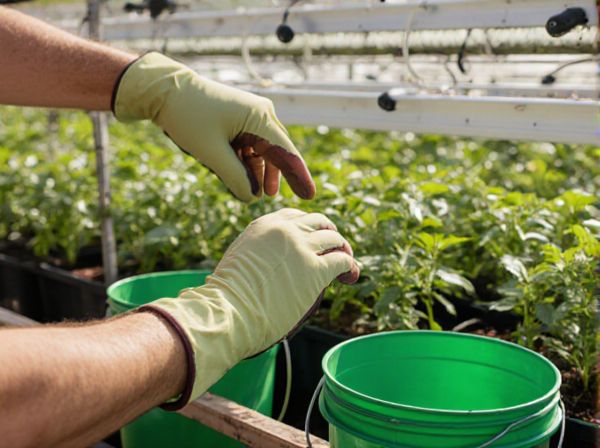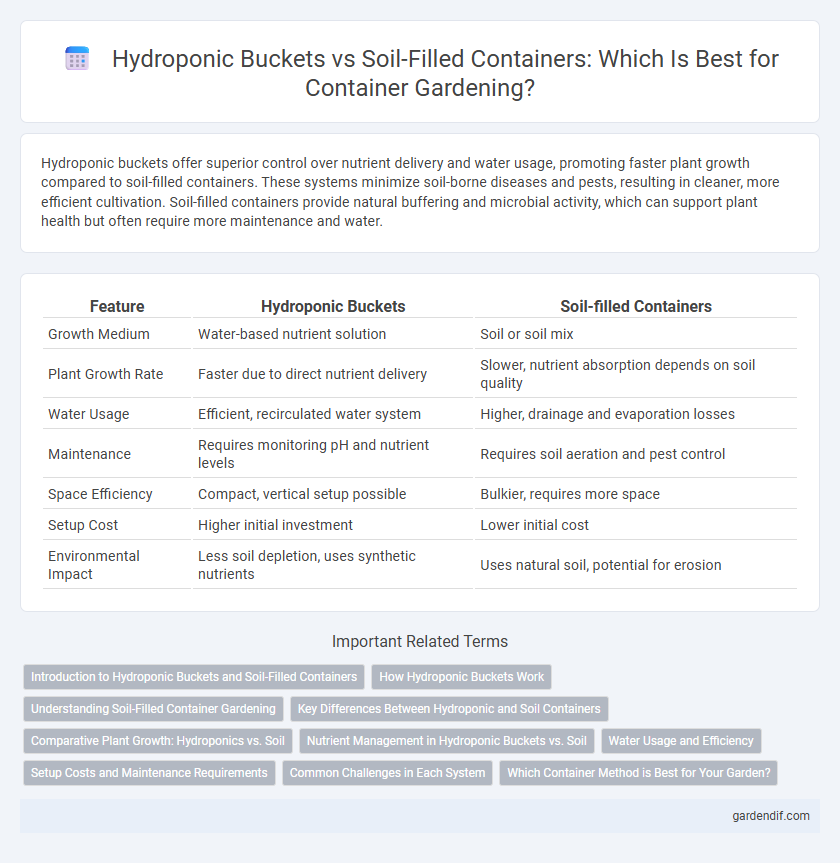
Hydroponic buckets vs Soil-filled containers Illustration
Hydroponic buckets offer superior control over nutrient delivery and water usage, promoting faster plant growth compared to soil-filled containers. These systems minimize soil-borne diseases and pests, resulting in cleaner, more efficient cultivation. Soil-filled containers provide natural buffering and microbial activity, which can support plant health but often require more maintenance and water.
Table of Comparison
| Feature | Hydroponic Buckets | Soil-filled Containers |
|---|---|---|
| Growth Medium | Water-based nutrient solution | Soil or soil mix |
| Plant Growth Rate | Faster due to direct nutrient delivery | Slower, nutrient absorption depends on soil quality |
| Water Usage | Efficient, recirculated water system | Higher, drainage and evaporation losses |
| Maintenance | Requires monitoring pH and nutrient levels | Requires soil aeration and pest control |
| Space Efficiency | Compact, vertical setup possible | Bulkier, requires more space |
| Setup Cost | Higher initial investment | Lower initial cost |
| Environmental Impact | Less soil depletion, uses synthetic nutrients | Uses natural soil, potential for erosion |
Introduction to Hydroponic Buckets and Soil-Filled Containers
Hydroponic buckets utilize nutrient-rich water solutions to promote optimal plant growth without soil, enhancing oxygen availability and root efficiency. Soil-filled containers rely on natural soil's texture and microbial activity to support plant development, providing organic nutrients and a stable root environment. Comparing these methods highlights hydroponic buckets' ability to reduce water usage and accelerate growth cycles compared to traditional soil-filled containers.
How Hydroponic Buckets Work
Hydroponic buckets use a nutrient-rich water solution to deliver essential minerals directly to plant roots, eliminating the need for soil. These buckets typically feature a reservoir, an air pump for oxygenation, and net pots that hold the plants while their roots dangle in the nutrient solution. This method enhances nutrient absorption efficiency and accelerates plant growth compared to traditional soil-filled containers.
Understanding Soil-Filled Container Gardening
Soil-filled containers offer natural nutrient dynamics and microbial activity essential for plant growth, making them ideal for traditional gardening methods. These containers support a wide range of crops by providing a stable medium for root development, enhanced moisture retention, and organic matter integration. Understanding soil composition, drainage, and aeration is crucial for optimizing plant health and maximizing yields in container gardening.
Key Differences Between Hydroponic and Soil Containers
Hydroponic buckets utilize a nutrient-rich water solution to deliver essential minerals directly to plant roots, resulting in faster growth and higher yield compared to soil-filled containers that rely on natural soil composition and microbial activity for nutrient uptake. Hydroponic systems provide precise control over pH, nutrient concentration, and oxygen levels, whereas soil containers depend on soil quality, drainage, and organic matter content for plant health. Additionally, hydroponic buckets require less water overall and reduce the risk of soil-borne diseases commonly associated with soil-filled containers, making them a more efficient and sustainable option for controlled environment agriculture.
Comparative Plant Growth: Hydroponics vs. Soil
Hydroponic buckets enable faster plant growth by delivering nutrients directly to the roots in a controlled environment, resulting in higher yield efficiency compared to soil-filled containers. Plants grown in hydroponic systems often exhibit enhanced root oxygenation and reduced risk of soil-borne diseases. In contrast, soil-filled containers provide natural microbial interactions and organic matter that contribute to slower but potentially more resilient plant development.
Nutrient Management in Hydroponic Buckets vs. Soil
Hydroponic buckets offer precise nutrient management by delivering a carefully balanced, water-soluble nutrient solution directly to plant roots, eliminating nutrient variability and enhancing uptake efficiency compared to soil. Soil-filled containers rely on the natural mineral content and microbial activity within the soil, which can cause inconsistent nutrient availability due to factors like pH fluctuations and organic matter decomposition. This controlled environment in hydroponic systems reduces the risk of nutrient deficiencies or toxicities, optimizing growth and yield.
Water Usage and Efficiency
Hydroponic buckets use up to 90% less water compared to traditional soil-filled containers due to recirculating nutrient solutions, enhancing water-use efficiency in plant growth. Soil containers experience higher water loss through evaporation and runoff, resulting in increased water consumption and less control over hydration levels. Hydroponic systems optimize water delivery directly to roots, promoting faster growth with reduced resource waste.
Setup Costs and Maintenance Requirements
Hydroponic buckets typically have higher initial setup costs due to the need for pumps, nutrient solutions, and grow media, whereas soil-filled containers are more affordable upfront, relying mainly on soil and basic pots. Maintenance for hydroponic systems involves monitoring pH levels, nutrient concentration, and water quality regularly, while soil containers require less frequent attention, primarily focusing on watering and soil fertility management. Long-term operational costs of hydroponic buckets can be offset by faster growth rates and higher yields compared to traditional soil containers.
Common Challenges in Each System
Hydroponic buckets often face challenges such as nutrient imbalance, root oxygenation issues, and waterborne diseases due to a closed water system. Soil-filled containers commonly struggle with inconsistent moisture levels, soil compaction, and pest infestations that affect plant health. Both systems require careful management of their respective root environments to optimize growth and minimize stress factors.
Which Container Method is Best for Your Garden?
Hydroponic buckets offer precise control over nutrient delivery and water usage, resulting in faster plant growth and higher yields compared to soil-filled containers, which provide natural microbial activity and better support for root structure. Choosing the best container method depends on factors like the type of plants grown, space availability, and maintenance preferences. Gardens with limited space or water supply benefit from hydroponic systems, while traditional soil containers excel in promoting biodiversity and ease of use.
Hydroponic buckets vs Soil-filled containers Infographic

 gardendif.com
gardendif.com